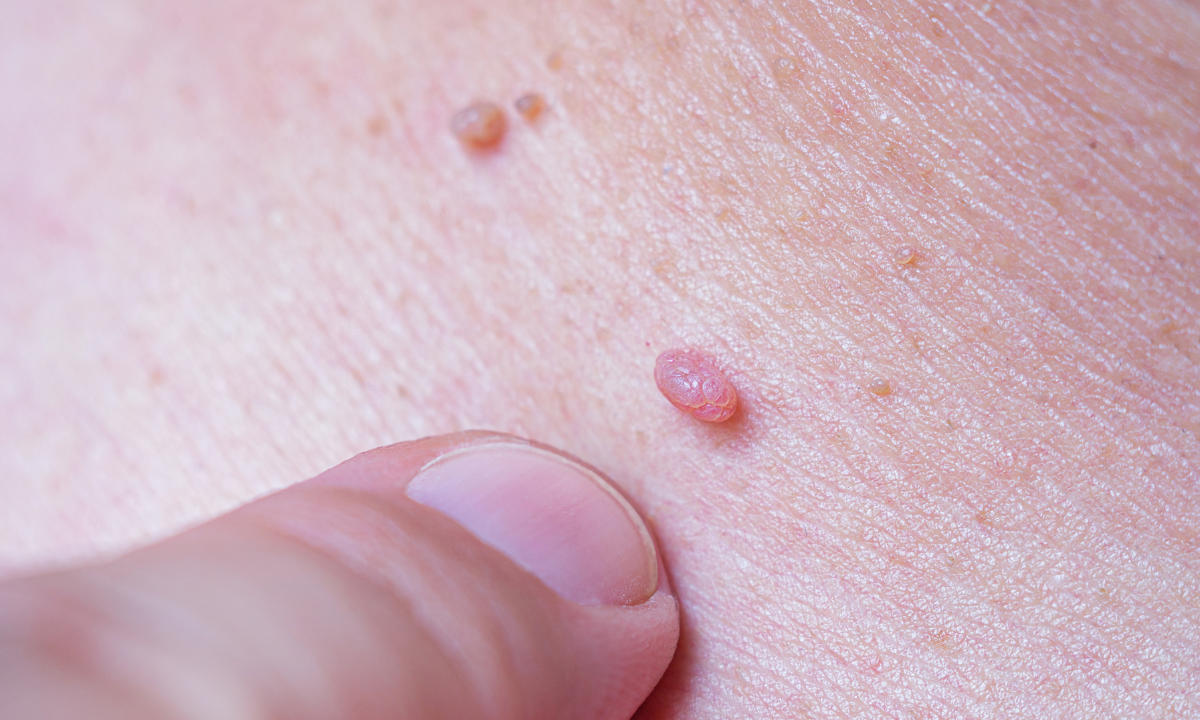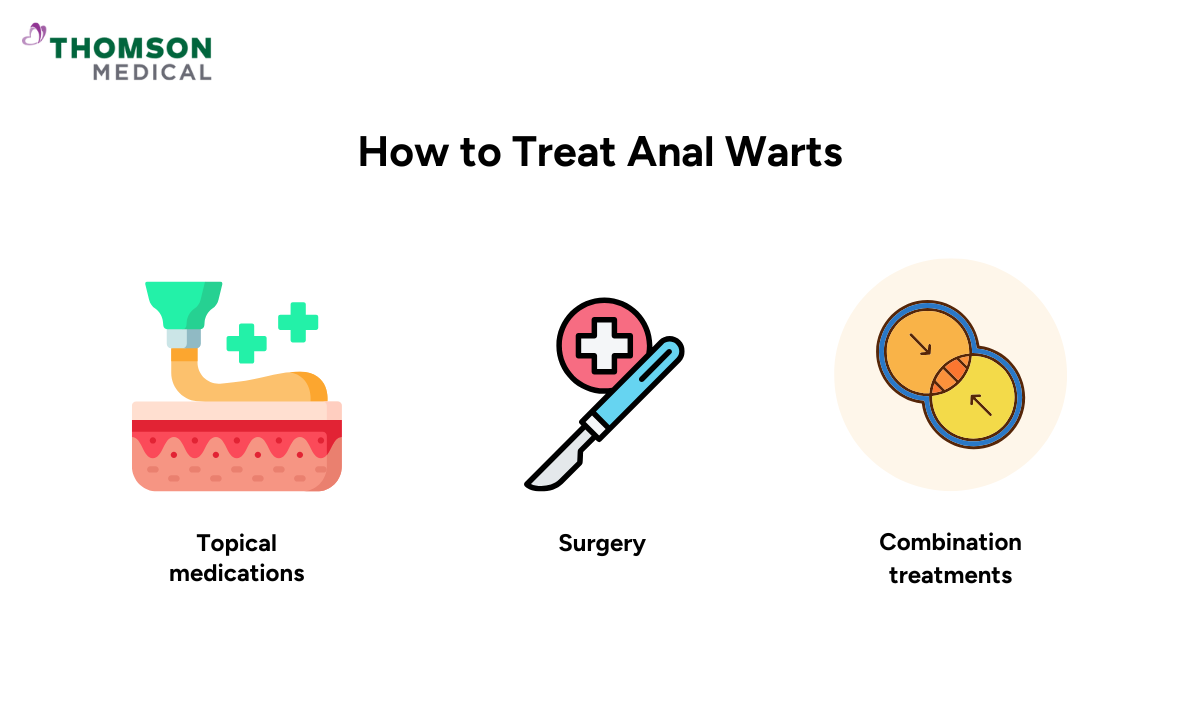Anal warts are small, soft bumps that grow on the skin around the anus which are caused by human papillomavirus (HPV). They don't always hurt, but they can cause discomfort, itching, and bleeding which can affect your sexual health and quality of life.
To effectively manage and stop the disease from coming back, it is important to know the causes, risk factors, symptoms, and treatment options.
What are anal warts?
Anal warts (also known as condyloma acuminata) are found inside and around the area of the anus. They look like small, pinhead-sized spots or grow into bigger, cauliflower-like bumps. Warts may be light brown, pink, yellow, or the colour of flesh.
Anal warts are a type of genital wart, which means that warts can also appear on other areas of the body at the same time. In women, genital warts may develop on the vulva, inside the vagina, or on the cervix. In men, they can appear on the penis, scrotum, thighs, or groin.
Cause of anal warts
Certain types of human papillomavirus (HPV), most commonly HPV 6 and 11, cause anal warts.
This virus is transmitted from one person to another through direct contact with the mouth, anus, penis, or vagina of someone with an HPV infection. Sexual activity is not necessary, as HPV can also spread via skin-to-skin contact. Transmission can occur even when warts are not visible.
HPV can cause anal warts or lead to anal cancer. However, the strains that cause anal warts are generally low-risk and rarely linked to anal cancer.
Who is at higher risk of developing anal warts?
Anal warts can affect anyone, but certain factors can make some people more likely to develop them. You may be at higher risk of developing anal warts if you have any of the following factors:
Compromised immune systems (like people with HIV/AIDS or transplant recipients)
Multiple sexual partners
Men who have sex with men
Engaging in sexual activity without barrier protection
Starting sexual activity at a young age
Not having received the HPV vaccine
Signs of anal warts

Anal warts may not always show any signs at all. When symptoms appear, they can vary but often include:
Soft, flesh-coloured or light brown bumps appearing in or around the anus
Itching or irritation around the anal area
Bleeding
Mucus discharge from the anus
A lump or mass in the anal region
Pain or discomfort during bowel movements or sexual activity
These symptoms can differ in severity depending on the size, number, and location of the warts, and they may develop gradually over time.
Are you experiencing these symptoms or worried that you might be at high risk for anal warts? Make an appointment at Thomson Medical for a correct diagnosis and a consultation that is tailored to your needs.
How do doctors diagnose anal warts?
Your doctor will usually look at your medical history and do a physical exam to figure out if you have anal warts. During the examination, the doctor will visually inspect the anal area and may use an anoscope to look inside the anus.
In some cases, a biopsy, which is taking a small piece of tissue, may be performed. This is usually done if the warts appear suspicious, atypical, or resistant to treatment, or if you have a weak immune system.
HPV tests are generally not recommended for diagnosing anal warts, as they cannot reliably differentiate between low-risk strains (which cause warts) and high-risk strains (which can lead to cancer).
Our specialists
Loading...
How to treat anal warts

There are different ways to treat anal warts, depending on their size, location, and severity. These include medications that are applied to the skin, surgery, or a mix of the two.
Topical treatments
Topical medications are often the first-line treatment for managing anal warts and work through different mechanisms depending on the specific drug.
Some creams stimulate the immune system to fight the warts or directly target the wart tissue to reduce their size and appearance, including:
Imiquimod (Aldara, Zyclara)
Podofilox (Condylox)
Sinecatechins (Veregen)
Other chemical treatments are applied by a healthcare professional to destroy the warts by breaking down the affected tissue, such as:
Trichloroacetic acid (TCA)
Bichloroacetic acid (BCA)
You should only use topical treatments under your doctor’s guidance, as improper use may cause irritation or reduce effectiveness. Do not use over-the-counter products that may not be suitable for your condition.
Surgical treatments
Surgical treatment for anal warts involves removal through techniques like:
Excision (surgical removal):
A scalpel is used to cut away the warts, and dissolvable stitches may be used to close the wound.
Electrocautery (diathermy):
Warts are burnt off with a low-voltage electric current, which also seals blood vessels, eliminating the need for stitches.
Laser ablation:
A high-energy beam of light is used to destroy the warts and seal the blood vessels.
Loop electrosurgical excision procedure (LEEP):
A wire probe with a loop is used to cut off the warts.
These outpatient procedures are performed under local or general anaesthesia. After surgery, regular follow-up appointments are essential to monitor for recurrence, as HPV can remain inactive in the body's tissues and cause new warts to appear.
Combination treatments
Combination treatments for anal warts often involve combining destructive therapies like electrocautery, laser therapy, or surgical excision with topical medications such as imiquimod cream to lower recurrence rates.
Photodynamic therapy (PDT) is a treatment that uses light-sensitive medicine and a light source to destroy abnormal cells. When combined with oral retinoids like acitretin, it has shown promise for intra-anal warts, with high cure rates and lower recurrence.
Glycyrrhizic acid (Gly) used both topically and orally has also been shown to work on external warts.
To get the best results from treatment and lower the risk of recurrence, schedule an appointment with our O&G specialists at Thomson Medical for personalised treatment planning and long-term follow-up.
FAQ
How do I get anal warts?
Anal warts are a sexually transmitted infection (STIs) caused by specific strains of human papillomavirus (HPV), particularly HPV 6 and 11. Skin-to-skin contact during any type of sexual activity, including anal, oral, or genital sex, can spread them. Sometimes, direct contact with the infected area is enough to spread them, even if there is no penetration. The virus is contagious, and warts can spread even when there are no visible symptoms.
Do I have haemorrhoids or warts?
Both anal warts and haemorrhoids can look like bumps near the anus and make you itch or hurt, which makes it easy to mix them up. But these two conditions are different in these ways:
| Hemorrhoids | Anal warts | |
| Cause | Pressure on blood vessels | Human papillomavirus (HPV) |
| Appearance | Swollen blood vessels, often appearing as dark red or purple, uniform lumps | Soft, flesh-colored to light-brown, and can have a cauliflower-like appearance |
| Pain and bleeding | Painful and cause bright red bleeding | Often painless but may bleed if irritated or scratched |
| Location | Lumps and itching around the anus | Can appear in other areas around the genitals |
Without a doctor's diagnosis, you can't be sure if you have haemorrhoids or warts. If you feel any symptoms, it's important to see a doctor quickly to get the right diagnosis and treatment.
What causes warts on the bottom?
Certain types of human papillomavirus (HPV), most often HPV 6 and 11, cause anal warts. When HPV gets into the skin, it can cause cells to grow abnormally, which can cause soft, flesh-coloured or light brown warts to form in or around the anal area. These strains are usually low-risk and don't often cause anal cancer, but the virus can stay in the body even after warts are gone.
Is HPV with warts for life?
HPV doesn’t always cause warts that last forever. Warts can be removed with treatment, but the virus may still be in the body, which can cause them to come back. Warts can go away on their own, stay the same, or get bigger. The immune system usually gets rid of HPV in two years, but some strains can stay in the body and cause warts to come back or lead to more serious health problems.
Do anal warts hurt?
No, anal warts don't usually hurt, which can make them hard to see. Some people may feel mild discomfort, itching, or a small lump around the anal area. However, if the warts become larger or increase in number, they can cause irritation or pain.
Do anal warts spread?
Anal warts are contagious and can spread easily through direct skin-to-skin contact, often during sexual activity. They are caused by HPV, which can be transmitted even when no visible warts or symptoms are present.
The information provided is intended for general guidance only and should not be considered medical advice. For personalised recommendations and advice based on your unique situation, please consult a specialist at Thomson Medical. Request an appointment with Thomson Medical today.
For more information, contact us:
Thomson ParentCraft Centre
Thomson Specialists (Women's Health)
Thomson Women's Clinic (TWC)
- Novena:
6592 6686 (Call), 8611 8986 (WA) - Bukit Batok:
6569 0668 (Call), 8686 3525 (WA) - Choa Chu Kang:
6893 1227 (Call), 8282 1796 (WA) Jurong:
6262 8588 (Call), 6262 8588 (WA)- Katong (female doctor):
6970 2272 (Call), 8611 9020 (WA) - Punggol:
6243 6843 (Call), 8811 0328 (WA) - Sembawang: 6753 5228
- Sengkang: 6388 8125
- Serangoon (female doctor): 6382 3313
- Tampines: 6857 6266
- Tiong Bahru: 6276 1525
